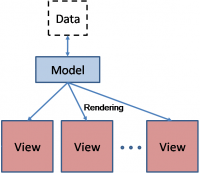EVS
(New page: The Edit-based Validation System (EVS) provides a graphical user interface (GUI) useful for segmentation result viewing and editing. The GUI is built using a cross-platform framework for ...) |
|||
| Line 1: | Line 1: | ||
| − | The Edit-based Validation System (EVS) provides a graphical user interface (GUI) useful for segmentation result viewing and editing. The GUI is built using a cross-platform framework for open-source application development called Qt ([http://www.qtsoftware.com qtsoftware.com]). | + | The Edit-based Validation System (EVS) provides a graphical user interface (GUI) useful for segmentation result viewing and editing. The GUI is built using a cross-platform framework for open-source application development called Qt ([http://www.qtsoftware.com qtsoftware.com]) and Kitware's Visualization Toolkit ([http://www.vtk.org VTK]). |
== Model-View Programming == | == Model-View Programming == | ||
| + | [[Image:Model-view.PNG|thumb|200px|right|The Model/View Architecture allows for many views of the same data]] | ||
The model/view architecture is based on the model-view-controller (MVC) software design pattern from computer science. "MVC consists of three kinds of objects. The model is the application object, the View is its screen presentation, and the Controller defines the way the user interface reacts to user input" (Gamma, 1995). Combining the view and controller objects leads to the model/view architecture. The model contains the location of the source data and provides the interface to the data, all editing and retrieving of data must be done through the model. The view obtains indexes or pointers to the data, from the model, and renders the data appropriately. It is possible to create many views which render the data in the same model. All editing of the data must go through the model interface. | The model/view architecture is based on the model-view-controller (MVC) software design pattern from computer science. "MVC consists of three kinds of objects. The model is the application object, the View is its screen presentation, and the Controller defines the way the user interface reacts to user input" (Gamma, 1995). Combining the view and controller objects leads to the model/view architecture. The model contains the location of the source data and provides the interface to the data, all editing and retrieving of data must be done through the model. The view obtains indexes or pointers to the data, from the model, and renders the data appropriately. It is possible to create many views which render the data in the same model. All editing of the data must go through the model interface. | ||
| + | |||
| + | In the EVS we refer to the model/view architecture as ALISA (Actively Linked Integrated Spaces Architecture). ALISA provides multiple views of segmentation object data. These views include a result overlay, three-dimensional renderings, table views of the features, and multiple two-dimensional scatter-plot views of the features. All views are actively linked meaning that the result of selecting or editing objects can be seen in any space instantaneously. A subset of the edit operations is available in any one of the views. Segmentation results may be validated using group edit-based validation protocols, see [[]] for more detail. Group edits significantly reduce the effort required to validate a segmentation result. | ||
Revision as of 16:41, 24 April 2009
The Edit-based Validation System (EVS) provides a graphical user interface (GUI) useful for segmentation result viewing and editing. The GUI is built using a cross-platform framework for open-source application development called Qt (qtsoftware.com) and Kitware's Visualization Toolkit (VTK).
Model-View Programming
The model/view architecture is based on the model-view-controller (MVC) software design pattern from computer science. "MVC consists of three kinds of objects. The model is the application object, the View is its screen presentation, and the Controller defines the way the user interface reacts to user input" (Gamma, 1995). Combining the view and controller objects leads to the model/view architecture. The model contains the location of the source data and provides the interface to the data, all editing and retrieving of data must be done through the model. The view obtains indexes or pointers to the data, from the model, and renders the data appropriately. It is possible to create many views which render the data in the same model. All editing of the data must go through the model interface.
In the EVS we refer to the model/view architecture as ALISA (Actively Linked Integrated Spaces Architecture). ALISA provides multiple views of segmentation object data. These views include a result overlay, three-dimensional renderings, table views of the features, and multiple two-dimensional scatter-plot views of the features. All views are actively linked meaning that the result of selecting or editing objects can be seen in any space instantaneously. A subset of the edit operations is available in any one of the views. Segmentation results may be validated using group edit-based validation protocols, see [[]] for more detail. Group edits significantly reduce the effort required to validate a segmentation result.
